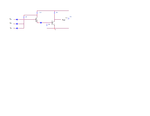userXY
Junior Member level 1
For the circuit in attachment1, determine the logic function and minimum resistance value of the resistor Rcmin such that the output transistor is in saturation state when it is on.
If the output transistor is charged with capacitor Cp=220nF, determine the fall and rise time of the output voltage.
Given data: βmin=50, β=100, Vcc=5V, Ubet=0.5V, Ubes=0.7V, Ube=Ud=0.6V, Uces=0.2V.
Note: This is not homework, I am practicing for exam.
Attempt:
We consider the static analysis of a circuit (low and high logic level).
Note: I assumed that diodes are idealized (when it is forward biased the voltage is 0.6V, and when it is reverse biased, it is an open branch).
1. Low logic level (Vin=0V)
We don't consider this case because we can never have Vin=0V.
Is this correct?
2. High logic level (Vin=Vcc=5V)
We conclude that at least one input diode is forward biased.
Fourth diode (that is connected to emitter of input voltage) is reverse biased.
Output transistor is on. We need to check if it is in saturation state.
The condition is Ics>Ib/βmin. We can find Ib as Ib=Ubes/5k=0.14mA and Ics as Ics=Uces/Rcmin. This gives that Rcmin>200/7 Ω.
Is this correct?
Where to connect capacitor Cp and how to find fall and rise time of Vout?
What is the value of Vout in this case?
If the output transistor is charged with capacitor Cp=220nF, determine the fall and rise time of the output voltage.
Given data: βmin=50, β=100, Vcc=5V, Ubet=0.5V, Ubes=0.7V, Ube=Ud=0.6V, Uces=0.2V.
Note: This is not homework, I am practicing for exam.
Attempt:
We consider the static analysis of a circuit (low and high logic level).
Note: I assumed that diodes are idealized (when it is forward biased the voltage is 0.6V, and when it is reverse biased, it is an open branch).
1. Low logic level (Vin=0V)
We don't consider this case because we can never have Vin=0V.
Is this correct?
2. High logic level (Vin=Vcc=5V)
We conclude that at least one input diode is forward biased.
Fourth diode (that is connected to emitter of input voltage) is reverse biased.
Output transistor is on. We need to check if it is in saturation state.
The condition is Ics>Ib/βmin. We can find Ib as Ib=Ubes/5k=0.14mA and Ics as Ics=Uces/Rcmin. This gives that Rcmin>200/7 Ω.
Is this correct?
Where to connect capacitor Cp and how to find fall and rise time of Vout?
What is the value of Vout in this case?
